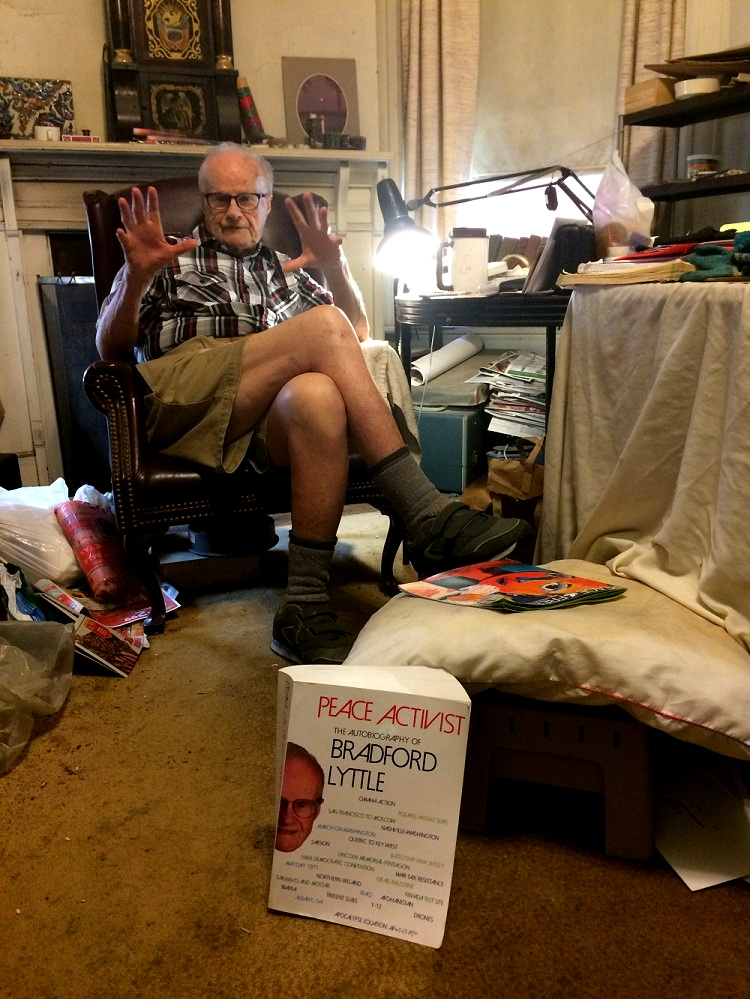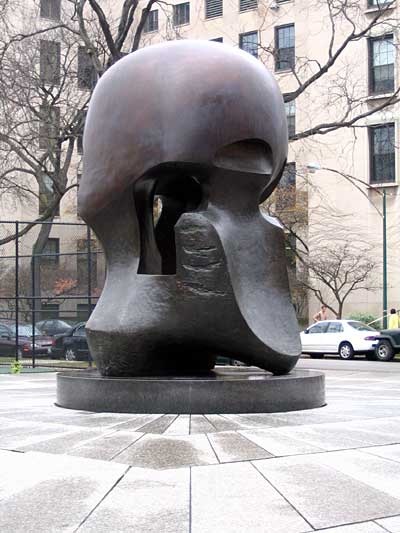
Like a moth drawn to a flame, 90-year-old Bradford Lyttle is drawn to the original flame of the most powerful force on earth, the nuclear bomb. He lives, and has lived for 43 years, six blocks from the Fermi Center in Chicago where 75 years ago on December 2nd, physicist Enrico Fermi produced the first self sustaining nuclear chain reaction, and the new world of nuclear power was born.
Lyttle frequents the place on the University of Chicago campus where the famous Nuclear Energy sculpture by Henry Moore is located and hands out leaflets and hawks his most recent book: The Flaw in Deterrence. “Living here is significant. It gives me access to a powerful political symbol,” he told me when I interviewed him this summer at his home on Dorchester Ave, in the Hyde Park neighborhood of Chicago.
The Flaw that consumes his life is that the calculations that underpin the risk or probability of an intentional or accidental nuclear launch are profoundly misunderstood. He calls them the Apocalypse Equation. Mutually insured destruction, or strategic deterrence, is the idea that if our nuclear weapons are powerful enough, and indestructible, no nation will attack us because they will be afraid that our military response will annihilate them.
In Lyttle’s own words: “The view that these arsenals can compose a stable deterrence system, and the missiles will never be deliberately launched in a strategic attack, is an illusion. Probability analysis shows that the probability of a strategic attack approaches certainty. In addition, the analysis shows that the probability of unauthorized missile launches also approaches certainty, and that this probability will increase as the number of missiles increases. These facts mean that deterrence, far from being a wise national policy that can insure national security, is about the most dangerous policy that can be conceived within the present scientific and technological state of civilization… Deterrence can be considered irrational partly because it inexorably tends to generate a catastrophe – a nuclear war that could destroy civilization and perhaps the human species – which is greater than the catastrophe it’s intended to prevent.”
Lyttle is a pacifist, and a Quaker. In graduate school, he studied social policy, statistics and mathematical modeling. He is passionately at odds with the institution that surrounds him. Years ago, when Lyttle was in the graduate program in political science at the University of Chicago, he was told by a professor “If you want a PhD from this department you will not express your opinion on any paper or test.”
He seems to have been considered a harmless sentimental pacifist. “Nobody has any interest in your ideas,” Joseph Cropsey, University of Chicago professor, and a follower of neo-conservative professor Leo Strauss told him. “Political philosophy is about winning. Napoleon destroyed monarchies and brought democracy.” Another professor told him “you don’t want to be on the wrong end of one of those battleship guns.”
The many years of banging his head against the positivist military atomic mindset at the University of Chicago has caused Lyttle to charge the University with being the most socially destructive institution the nuclear bomb has created. The idea that it has spawned, of nuclear deterrence, is a very malign influence. Although nuclear weapons dominance is the basis of our strength around the world, we are sitting on the verge of nuclear annihilation every moment. “The human species,” Lyttle says, “has created the machinery to destroy itself. “
Pope Francis agrees with Lyttle. While the church once held that nuclear deterrence could be moral and lawful it no longer views it as such. In a landmark statement on nuclear arms on November 10, Pope Francis categorically condemned not only “the threat of their use” but also “their very possession.” Also in considerable agreement, former defense secretary William Perry recently said that “the danger of a nuclear catastrophe today is greater than it was during the Cold War.”
On October 8, to the delight of anti-nuclear activists, the Nobel Peace Prize was awarded to the International Campaign to Abolish Nuclear Weapons – an umbrella organization including the Women’s International League for Peace and Freedom, and Physicians for Social Responsibility – for convincing 122 nations of the United Nations General Assembly to take the unprecedented decision to adopt a nuclear prohibition treaty.
This fall, the University of Chicago will kick off a series of public events to mark the 75th anniversary of Fermi’s chain reaction experiment. “Nuclear Reactions—1942: A Historic Breakthrough, an Uncertain Future,” will culminate in a two-day program on Dec. 1-2.

Meanwhile, the Nuclear Energy Information Center, a Chicago non-profit committed to ending nuclear power is holding a series of events of their own, sponsoring talks by Arnie Gundersen, a nuclear engineer and whistleblower from Burlington, VT. “The U. of C. calls their events a commemoration, but its really a celebration,” Gundersen argues. “I’ll be talking primarily about the dangers of nuclear power, and we know that nuclear reactors and bombs are inextricably intertwined.”
Perhaps Gundersen and Lyttle will meet during the commemorations/celebrations around the Henry Moore Nuclear Energy sculpture. The twelve-foot tall bronze sculpture was commissioned by the University of Chicago and created by British artist Henry Moore, one of the most preeminent public sculptors of his generation. In Moore’s mind, the sculpture was both a celebration of the incredible human achievement of splitting the atom, and also a warning against the dangers of harnessing such natural, physical power. In a commentary on the work, Moore said, “Like anything that is powerful, it has a power for good and evil… the lower part [of the sculpture] is more architectural and in my mind has the kind of interior of a cathedral with sort of a hopefulness for mankind. “
During these frightening months of an escalation of nuclear threats, its apparent that danger and hope are intertwined more than ever in our struggle for human survival.
Bradford Lyttle’s book, The Flaw in Deterrence, can be obtained through Amazon. Robin Lloyd is an activist with WILPF from Burlington VT. The petition asking individuals to support the ban treaty can be found here.
